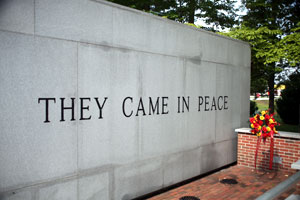Beirut Memorial
The official webpage for Marine Corps Base Camp Lejeune describes the background for the attack memorialized by this monument as follows:[1] "In the summer of 1982, at the request of the Lebanese government, the United States agreed to establish a U.S. Military presence in that country to serve as a peacekeeping force in the conflict between warring Muslim and Christian factions.
On March 24, 1983, the 24th Marine Amphibious Unit, stationed at Camp Lejeune, North Carolina, received orders to Beirut, Lebanon in support of that commitment.
This led to artillery, mortar, and small arms fires being directed at the Marine Corps positions—with appropriate, measured response being taken against identified targets.
In the early morning of October 23, 1983, the First Battalion, 8th Marines Headquarters building was destroyed by a non-Lebanese, terrorist-driven truck, laden with compressed gas-enhanced explosives.
The court finds that beyond question Hezbollah and its agents received massive material and technical support from the Iranian Government.”[3] Major Robert T. Jordan, USMC (Ret), one of the Marine officers present during the attack, has written that "The men who served with 24th MAU during the final, grim months of 1983, have taken their place alongside earlier Marines who endured at Samar, Wake Island, Chosin Reservoir, and Khe Sanh.
[1] Immediately after the Beirut barracks bombing, the Commission met to consider ways to memorialize the peacekeepers who died in the attack, ultimately requesting permission to plant additional trees on Lejeune Boulevard, the street linking the city to the Marine Corps Base.
[1] News spread about this plan, attracting donations on a national level, a response considered by the Commission as the "birth of the Beirut Memorial.
[8] There is a Beirut Memorial Room in the USO in Jacksonville, North Carolina, that includes a wall with the names of all those who died in the attack, along with the words "They Came in Peace.
[10] According to Rabbi Arnold Resnicoff, one of the Navy chaplains present during the attack, "Amidst the rubble, we found the plywood board which we had made for our "Peace-keeping Chapel."
"[10] Other memorials to the victims of the Beirut barracks bombing have been erected in the United States, including those at Penn's Landing in Philadelphia, Pennsylvania, and Florida.




